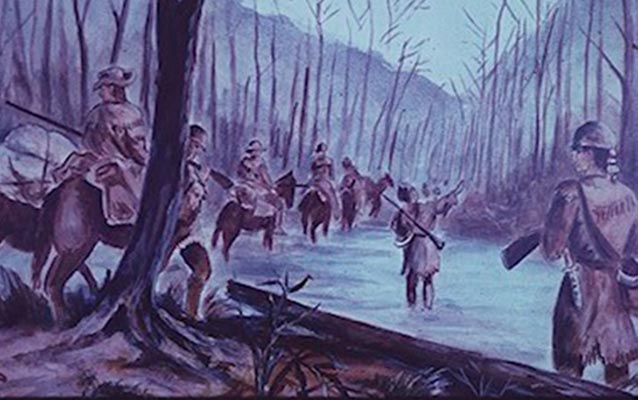The Natchez Trace Parkway: a Wealth of Recreational Assets
 On the Natchez Trace Parkway, a wealth of recreational assets makes for endlessly repeatable, all-season fun.
On the Natchez Trace Parkway, a wealth of recreational assets makes for endlessly repeatable, all-season fun.
It’s true that Mother Nature did her part, and so did Father Time, melding their talents to bring forth a spectacular natural setting rich in plant and animal life. But when it came to transforming the 444 miles of the Natchez Trace Parkway into a year-round outdoor paradise stretching from Natchez to Nashville, human planning was actually the key.
The Parkway was designed first and foremost for history, to preserve the Old Natchez Trace, which dated back to prehistoric times and stretched into the heart of American history as a primary route for American Indians and early white settlers. With the advent of steam travel on the Mississippi River, the Trace fell into disuse, and by the late 1930s the road was about to disappear; the Natchez Trace Parkway was the federally supported preservation solution.

And while preserving the Old Trace was the primary purpose of the Parkway, Stennis Young, former Parkway Assistant Superintendent, says the project was undertaken with a broad picture in mind. “The Parkway was also designed to benefit local communities in providing a good mode of transportation as well as economic and cultural benefits. Recreation was an important part of the plan for those benefits.”
The result is all-season fun for all ages and outdoor lovers of all stripes. Land, water, plant, animal, the Parkway offers a multitude of ways to play and a dazzling array of places to simply soak in the natural wonders of a beautifully preserved landscape.
Wildlife viewing, scenery stealing:
Bring a camera to capture the scene, or just your sense of wonder as you ramble through the wildflowers along the free-flowing stream at Sweetwater Branch or the moss-draped cypress trees of the darkly beautiful Cypress Swamp. Take in the dramatic sandstone cliffs at Bear Creek Canyon in Tishomingo State Park or the gorgeous waterfalls of the Shoals Creek Nature Preserve. Or make a stop at the Clinton Community Nature Center, 33 acres of meticulously conserved and cultivated natural habitat that is both a delightful retreat and a historical and horticultural showplace.

But, really, wherever you find yourself on the Natchez Trace Parkway, you’ll find the company irresistible, in an area that’s home to:
- 157 types of birds—the Parkway is a major American birding trail which is also part of the North Alabama Birding Trail
- 800 different types of plants
- 350 different types of wildlife, including at least 22 federally listed threatened or endangered species.
- A richly diverse ecosystem blending softwood and hardwood forests, wetlands and prairie landscapes, all of it generously interspersed with croplands.

Hunting, fishing and water fun:
Although hunting is not permitted on the Natchez Trace Parkway, adjacent communities offer hunting opportunities.
Hook it, hunt it, sail it, ski it; begin with a bang, end with a whopper (fish, that is—this is record catch country). The Parkway’s sporting adventures extend far and wide and deep, including:
- Shoals area hunting—38,000 acres of pristine, preserved hunting lands, offering hunting by permit for large and small game, and bow-hunting from October through January.
- Ross Barnett Reservoir—33,000 acres of water fun, stocked primarily with large-mouth bass. A haven for camping, fishing and water sports of all kinds.
- The Tennessee-Tombigbee Waterway—An engineering marvel connecting the Tennessee and Tombigbee Rivers. Travelers on the Parkway can dive into Waterway fun at the Jamie Whitten Lock and Dam and at Bay Springs Lake, well-equipped marinas and white sandy beaches.
- Pickwick Lake—The “Great Lake of the South,” stocked with record-size small mouth bass and catfish and stretching 50 miles across two states, encompassing 47,500 acres at full summer pool. Pickwick draws fishermen, campers, boaters and those who simply appreciate gorgeous scenery like the 50-foot Cooper Falls at J.P. Coleman State Park, skirting Pickwick with a marina, motel, cabins, RV spaces and campground.
- Wilson Lake—This 15,000-acre beauty has three previous world-records to its credit, for small mouth bass, freshwater drum and sauger. At the adjacent Veteran’s Park, there’s camping, fishing, boating, tennis and more.
*Please remember hunting is not permitted on the Parkway. If you have questions, please call the Parkway Visitor Center at 662-680-4014.

Hiking, biking, horses and Hawgs:
Easygoing and uncluttered, offering natural beauty rarely found outside off-road trails, the Parkway is a fixture on Top 10 and Top 100 bike roads, hailed by the GORP outdoor guide as a “treat.” Motorcyclists (on their Hawgs or other bikes) are also drawn here, for mile after mile of gently curving road and beautiful vistas around every bend.
And for those who want an off-road experience, the Parkway offers nearly 100 miles of happy trails, including:
- Over 60 miles of National Scenic Trail for hiking
- 52 different hiking, horse and nature trails, open year-round. Learn more about horseback riding here.

More fun under the sun—and the stars:
When Andrew Jackson marched his army up the Natchez Trace in 1815 the amenities were nearly nonexistent; today, the Parkways’ well-designed facilities for fun are legion, including:
- 12 state parks spread across Mississippi, Alabama and Tennessee.
- 10 campgrounds offering a range of campsites from primitive to RV.
- 5 bike-only campgrounds
- An abundance of golf courses located throughout the Parkway, including two courses on the famed Robert Trent Jones Trail.
Prehistoric beasts like giant bison and mastodons carved out the beginnings of the Natchez Trace; today, to have an epic outdoor adventure, all visitors have to do is carve out a little time. For a week, a weekend, a day or even an afternoon, the endlessly delightful, endlessly repeatable Natchez Trace Parkway is here to play, again, and again, and again.
FOR VISITOR INFORMATION: 866-TRACE 56
(866-872-2356)

